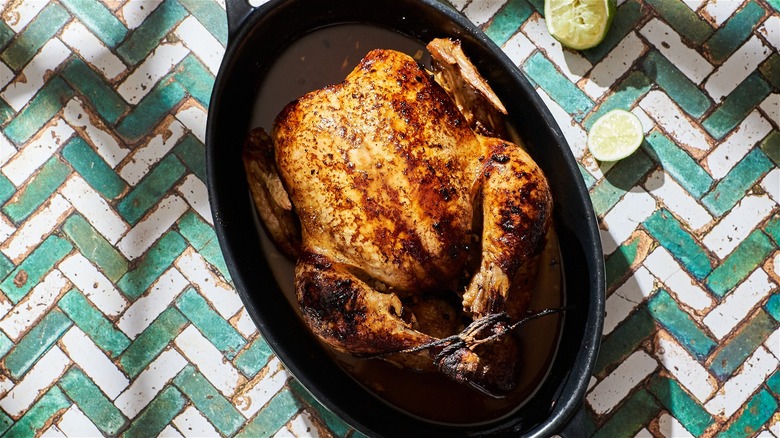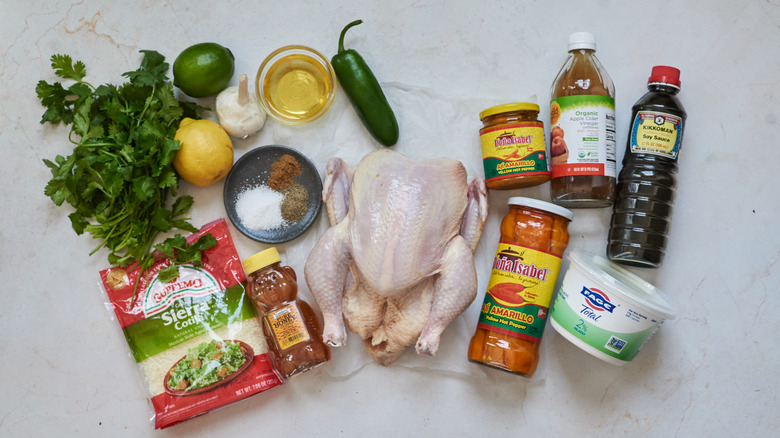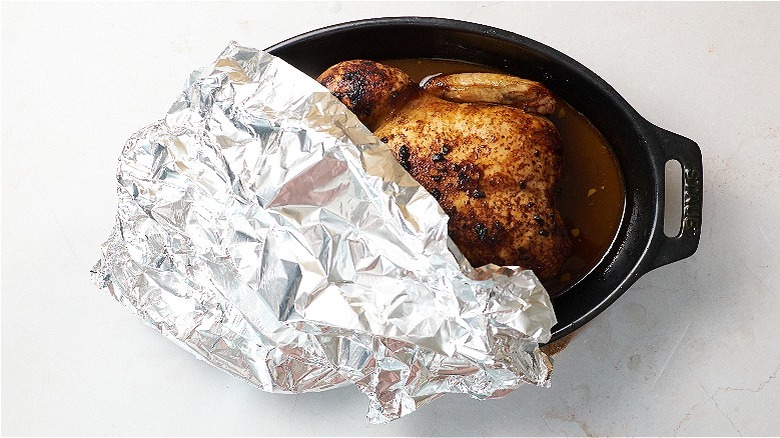Whole-Roasted Peruvian-Style Chicken Recipe
If you're at all familiar with lomo saltado, you know how delicious Peruvian food can be. The melting pot of culture is a mixture of Indigenous, European, African, and Chinese cuisine, borrowing techniques, flavors, and ingredients from the immigrants that came through Peru. It's why you see dishes with soy sauce, cilantro, and chili peppers stir-fried and served with French fries. It's also how one of Peru's most famous dishes pollo a la brasa came to be.
The grilled chicken dish is actually not that old and is made differently all over Peru and in America. The original was cooked by a Swiss national, Roger Schuler, who opened a restaurant serving chicken to survive during the Second World War. The chicken itself wasn't so much of a cultural phenomenon as was the method, which Schuler purportedly invented as a means to cook more chicken at once. This method was a spit roast over hot coals, a method of grilling not unlike a rotisserie and used by Peruvians today.
While it's unlikely you have el rotombo spit roast at home, you probably have a decent oven and a casserole dish. With a few simple tools, some fresh citrus, and a jar of aji amarillo paste, you can make this recipe written by Michelle McGlinn for juicy, flavorful, crispy-skinned Peruvian chicken at home. It might not have that smoky grilled flavor, but it's a seriously delicious consolation.
All the ingredients you need for a whole-roasted, Peruvian-style chicken
First, you'll need a whole chicken. You could make this recipe with small game hens, fryer chickens, or roasters, with the only thing being changed the roasting time. This recipe is developed using a fryer chicken, which is typically a mid-range 3 to 5 pounds and serves 4 with sides. This is about the size you'll see on the hot rotisserie-to-go shelves at the grocery store.
Next, you'll need olive oil, lime, cumin, salt, pepper, garlic, soy sauce, honey, and aji amarillo paste. You'll also be using full aji amarillo peppers, which you can substitute with the paste that is easier to find. For either, try your local Hispanic market in the Peruvian sections.
For the aji verde sauce, you'll also need a bunch of cilantro, Greek yogurt, a little bit of jalapeño, lemon juice, cotija cheese, and apple cider vinegar. If you're having a hard time finding cotija cheese, swap for parmesan.
Marinate the chicken
Part of the success of good roasted chicken is in the marinade. Whisk together the oil, lime, cumin, salt, pepper, garlic, soy sauce, honey, and aji amarillo paste. Pour it over the chicken, into the cavity, and under the skin, and let any remaining drippings fill the bowl or pan under the chicken. Let it marinate overnight, if you can, for the best flavor and juiciness. When ready to cook, bring to room temperature for about 30 minutes (or as long as it takes your oven to heat up).
Preparing the chicken to roast
You've done most of the work already, but the chicken needs a few more steps before it hits the heat. Place the chicken in a roasting pan, baking dish, or cast iron skillet (If you refrigerated the chicken overnight, you will need to transfer it to a new dish). Pour any remaining marinade over the chicken, then use baking twine to knot the legs together above the cavity opening. If you have any extra garlic cloves or lemon wedges, feel free to stuff them into the cavity.
Mix together the aji verde sauce
Peruvian chicken is typically served with a sauce; either a white aioli-like sauce, a mustard-yellow hot sauce, or this green, herby pepper sauce. This sauce is a blended mixture of cilantro, aji amarillo, and either yogurt or mayonnaise, making it spicy, refreshing, and creamy. If you couldn't find aji amarillo, you can swap for the paste or use jalapeños instead.
Blend all the sauce ingredients together in a blender until very smooth. If using a food processor, the sauce will be chunky and spicier; in a blender, it will be smooth and a little more muted. If the sauce is too spicy, add a dollop of yogurt and another spoonful of cheese and try again.
Roasting Peruvian chicken
Roast the chicken until the skin is browned and crispy on all sides; you may need to rotate the roasting pan while cooking to ensure even browning. The best way to ensure a cooked chicken, though, is to use a thermometer — the temperature should read between 155 to 160 F when inserted into the breast. Remove the chicken at this point and tent the chicken in foil. In the foil, the chicken's internal temperature will rise to 165 F; then you will be ready to serve.
Serving the chicken and green sauce
With the chicken roasted, tented, and ready, and the green sauce mixed together, it's time to serve. Carve the chicken: If serving four, carve the chicken into breasts, legs, and wings to serve in pieces. If serving 2, split the chicken in half lengthwise and serve as-is.
Peruvian chicken is traditionally eaten with big, fluffy, steakhouse French fries and an array of sauces. Not only that, but the chicken is typically eaten by hand, sans fork and knife. Of course, the meal is yours to customize; drizzle aji verde sauce over top and serve with fries, rice, or even mashed potatoes. And use a fork, if you want to.

- 1 whole fryer chicken, 4-5 pounds
- ¼ cup olive oil
- Juice from 1 lime
- 1 teaspoon cumin
- 1 teaspoon salt, plus more to taste
- 1 teaspoon pepper
- 6 cloves garlic, divided
- 2 tablespoons soy sauce
- 1 tablespoon aji amarillo paste
- 1 tablespoon honey
- ½ cup Greek yogurt
- 1 cup cilantro
- ½ jalapeño, roughly chopped and deseeded
- 1 aji amarillo pepper (or 1 tablespoon aji amarillo paste)
- 1 tablespoon lemon juice
- 2 tablespoons cotija cheese
- 1 teaspoon apple cider vinegar
- In a small bowl, whisk together the olive oil, lime juice, cumin, salt, pepper, 4 cloves minced garlic, soy sauce, aji amarillo paste, and honey until combined.
- Place chicken in a bowl or baking dish and pat completely dry with a paper towel. Coat completely in the marinade, then let rest for 30 minutes at room temperature or overnight in the refrigerator.
- When ready to roast, preheat the oven to 350F. Place the chicken in a roasting dish or cast iron skillet and brush with the remaining marinade from the bottom of the marinade bowl.
- Roast the chicken for 1 hour, 30 minutes, basting every 30 minutes, until internal temperature registers between 155 to 160 F. If your chicken is less than 4 pounds, begin checking the temperature at 1 hour. If the chicken is close to 5 pounds, adjust time accordingly until internal temperature is reached.
- While the chicken is roasting, prepare the aji verde sauce. Combine yogurt, jalapeño, aji amarillo pepper, lemon juice, cotija cheese, 2 cloves garlic, apple cider vinegar, and a pinch of salt in a blender. Blend until completely smooth. Taste; season with more salt if needed. If the sauce is too spicy, add a dollop more of yogurt.
- Once the chicken is roasted and reads 160 F, remove it from the oven and tent it with foil for 5-10 minutes, until the temperature reaches 165 F.
- To serve, carve the chicken into pieces and serve with aji verde sauce.






